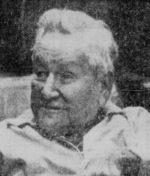 San Antonio Express (Staff Photo), September 6, 1968. Around midnight on August 21, 1925, two men entered the San Antonio, Texas, home of Mrs. Louisia Garcia and Mr. Gabriel Garcia. The two men claimed to need directions but soon beat both the Garcias unconscious. A trunk containing money was taken from the home. According to Gabriel Garcia, when Louisa Garcia temporarily regained consciousness, she told him that one of the perpetrators was Anastacio Vargas, a man who had worked for the Garcias several months earlier. Louisa Garcia soon died from her wounds. Vargas was quickly arrested for Louisa Garcia’s death, and Silverio Gomez was arrested as his accomplice. Gomez was separately indicted but he and Vargas were tried together. In addition to Gabriel Garcia’s identification of Vargas, a neighbor of the Garcias, Rosalio Velasquez, testified that she had seen Anastacio Vargas and Silverio Gomez arrive at the Garcia house on horseback on the night of the crime. Although Vargas offered an alibi in his defense, he was found guilty of robbery and murder in a Bexar County, Texas, court and sentenced to life in prison. On May 5, 1926, the Texas court of criminal appeals reversed Vargas’s conviction on the basis that the trial court had erred in refusing to grant Vargas a separate trial from Gomez. The case was remanded and Vargas was retried. At his second trial, he was convicted and, on October 6, 1926, sentenced to death. Vargas was scheduled to be executed in late 1927. He was shown the coffin he was to be buried in and had his head shaved preparation. He was served his last meal before he was to be executed but was then granted a reprieve by Governor Dan Moody so that Moody could further investigate a possible basis for a commutation of Vargas’s death sentence. This reprieve was then extended and on March 9, 1928, Governor Moody commuted Vargas’s death sentence to a life sentence after receiving a letter from the trial judge, Judge W. W. McCrory, stating that he was convinced of Vargas’s innocence. The letter from Judge McCrory referenced several pieces of evidence upon which he had relied in concluding Vargas was innocent, and stating that he had “no doubt that had the attorneys who represented Anastacio Vargas in either of his trials made an investigation into the facts that no jury would have ever found him guilty.” First, McCrory raised the issue of the timing and nature of Gabrial Garcia’s identification. He had learned that Gabriel Garcia had initially told neighbors that he did not know the identity of the attackers, but had later changed his story, about ten to twelve days after the attack, saying that his wife had identified Vargas before her death. When Vargas was brought to Gabriel Garcia’s bedside, Mr. Garcia, who was blind, identified Vargas as the culprit based solely on Vargas’s voice. McCrory also relied upon the shoe prints found at the scene of the crime, which were much smaller than Vargas’s feet. The attackers had arrived on horseback, but McCrory had learned there were no horses available at the ranch where Vargas worked. The commutation papers also referenced the testimony of Rosalio Velasquez, stating that the Appeals Court had subsequently found her testimony to be unsatisfactory. On October 21, 1929, Vargas received a full pardon from acting Governor Barry Miller. After decades of seeking compensation for his wrongful conviction, Vargas, age 76, was paid $21,966.40 as compensation by the State of Texas in September 1969. News articles and books from decades after Vargas’s convictions and pardon frequently reference another man – a Vargas lookalike – having confessed to the murder of Louisa Garcia immediately before Vargas’s scheduled execution, and such a confession having been the basis for the commutation and pardoning of Vargas. However in 1928 and 1929, when Vargas’s sentence was commuted and when his pardon was granted, no reference to any such confession could be located in the related court documents or news articles. – Meghan Barrett Cousino
|